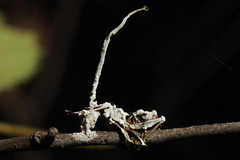
Image by myriorama via Flickr
If you’ve ever seen the movie Alien, you know what a parasitoid is. Parasitoids are quite similar to parasites, except instead of coexisting with their hosts, they ultimately kill them (like the chest-bursting creature of the aforementioned film).
Parasitoids aren’t merely figments of science fiction, though. They exist in nature all around us. One example is the fungus Ophiocordyceps unilateralis, an organism that infects carpenter ants and alters their behavior. According to Wikipedia,
The fungus’s spores enter the body of the insect through its respiratory spiracles, where they begin to consume the non-vital soft tissues. When the fungus is ready to spore, its mycelia enter the ant’s brain and change how it perceives pheromones, causing the insect to climb up the stem of a plant and use its mandibles to secure itself to the plant. Infected ants bite the leaf veins with abnormal force, leaving telltale dumbbell-shaped marks.
This creeps me out, to be honest. According to Harvard scientist David Hughes, “This can happen en masse. You can find whole graveyards with 20 or 30 ants in a square metre.
Each time, they are on leaves that are a particular height off the
ground and they have bitten into the main vein before dying.”
It turns out, interestingly, that this fungus has been extant for nearly 50 million years, if not longer. Researchers recently discovered fossilized evidence of the fungus’s influence:
The gruesome hallmark of the fungus’s handiwork was found on the
leaves of plants that grew in Messel, near Darmstadt in Germany, 48m
years ago.The finding shows that parasitic fungi evolved the
ability to control the creatures they infect in the distant past, even
before the rise of the Himalayas.
You can read more here.

